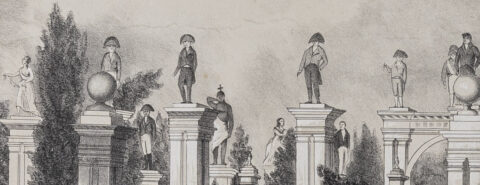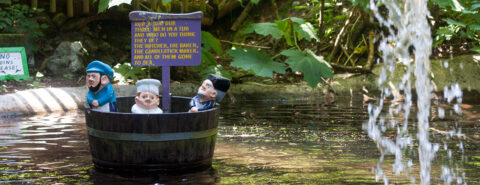Oxford University Press's Blog, page 27
May 7, 2024
Finding the classics in World War I poetry

Finding the classics in World War I poetry
It is a paradox that interest in the cultures of ancient Greece and Rome has increased at the same time that the extent of detailed knowledge about Greece, Rome, and the associated languages has declined. This affects perceptions about antiquity in the public imagination and among creative writers. Readers and new writers have many different starting points that shape how they first encounter the ancient texts and their receptions. Oxford Classical Reception Commentaries focus on the interactions between ancient texts and how they have been read and reworked across time, place, and language. We the editors have started from the premise that analysis of close textual relationships both enriches and is enriched by further ways of creating and describing connections—for example, through perceptions about figures such as Achilles; through associations generated by mediating literature and art; through the intense pressures of contexts and the lived experience of writers, readers, and scholars. All these can turn a low-level generalised awareness into a heightened perception of the continuing creative force of ancient cultures in the modern world.
The pivotal role of classical connections in World War I poetry shaped our choice for the first phase of OCRC, which will be in print and online. The poetry that emerged from the battlefields of the First World War influenced how that war was regarded at the time and subsequently. The commentaries offer insights into the many-faceted poetry of unease associated with WWI, an unease that ranged from fear of fear itself to challenges to the political and ethical rationales associated with the war. The poetics of unease co-existed with the poetry of survival, which was also multi-faceted, encoding strategies for living in the moment as well as for coping with trauma.
We have chosen to focus on four poets, all of whom died in the war: Rupert Brooke, Charles Hamilton Sorley, Wilfred Owen, and Isaac Rosenberg. All produced fine and memorable poems that continue to be read and appreciated today. All made distinctive use of classical material. They differed considerably in education and class background. Brooke and Sorley received a classical education in the elite schools of the time. Owen received a ‘middling’ education and tried to acquire some Latin. Rosenberg, the only non-officer among the four, was from a poor family, had limited education, and did not read Latin or Greek, but as an autodidact acquired an extensive knowledge of literature in English. Mapping how their poems interacted with classical material therefore entails a considerable range of connections. The commentaries also discuss how the chosen poets engaged with earlier texts in English and how their work in turn influenced other writers (e.g., Brooke and W. B. Yeats; Rosenberg, Pound and Douglas; Owen and Longley). In the commentaries on individual poems, we have not hesitated to experiment with a range of approaches and to ‘stretch’ the boundaries of conventional analysis of classical receptions.
Rupert Brooke’s small war output includes one of the most cited poems of WWI. His sonnet ‘The Soldier’, which begins ‘If I should die, think only this of me’, is still studied in schools and universities; this is despite its young author’s naïve enthusiasm for the combat which he was never really to experience (he died of an infected insect bite en route to the Gallipoli campaign in northwest Turkey), much criticised in later commentary. It was published in The Times and read aloud in St Paul’s Cathedral as a public promotion of positivity about the war and the new front opening up in the East.
Our commentary shows for the first time that this famous poem draws on a rich range of classical texts for its key content and even its form: the idea of fighting and being buried in a ‘foreign field’ evokes the Greek expedition to Troy and its fatal consequences for many of them, as narrated in Greek epic (Homer) and tragedy (Aeschylus), while its length and theme fit those of the brief Greek epitaphic epigram. Such echoes of the Trojan War are very fitting for a poem which imagines the author’s death in a campaign which was about to take place at Gallipoli in Turkey, very close to the site of ancient Troy where Homer’s heroes had fought each other in the Iliad, a proximity of which Brooke and his similarly educated fellow officers were fully aware.
Brooke’s sonnet had immediate impact on other war writers. There is a strong case that it influenced another famous poem of WWI, W. B. Yeats’ ‘An Irish Airman foresees his Death’ (1919). Yeats had met Brooke before the war and admired his good looks, and both poems present in the first-person ideas about dying in war—idealistic for Brooke, more fatalistic for Yeats. In particular, the opening words of Yeats’ airman (representing a real friend who was lost in the air for the then Royal Flying Corps, the future RAF ), ‘I know that I will meet my fate’, looks like a firm response to Brooke’s opening, ‘If I should die’, and the overall view of Yeats’ airman, that he has no patriotic stake in the war himself, looks like a reaction to Brooke’s nationalistic claim that his future grave will be ‘a corner of a foreign field / that is forever England’.
In a future post, we shall look at how Wilfred Owen drew on classical material to add a critical edge to his poetry. We also outline how Isaac Rosenberg’s Trench poems relate Greek and Hebrew sources to the environment of war-time Flanders.
Messy, messy masculinity: The politics of eccentric men in the early United States

Messy, messy masculinity: The politics of eccentric men in the early United States
For every weirdo one finds while researching the past’s forgotten personalities, there are probably two or three more just a stone’s throw away whom time did not preserve. At least that is the realization I had while researching and writing Feeling Singular: Queer Masculinities in the Early United States, a monograph which looks at the cultural detritus that never cohered into more stable or now canonical figures.
When creatives have set their work in the early United States, they’ve turned to Ron Chernow to imagine Hamilton or David McCullough to produce John Adams, but those stories buttress popular and well-trod fantasies about so-called great men to make mythic something that was far messier. Take, for instance, the eccentric and self-declared “Lord” Timothy Dexter who commissioned wooden statues of himself, and others, and placed them in his front yard in Newburyport, MA. He even faked his death to witness how his family would mourn him at his own funeral. Dexter’s excessiveness tells us something about the way masculinity sometimes manufactures messes for attention.
The impulse to be remembered as significant has a much longer history than our current moment of immediacy might suggest.
Building upon this impulse toward a queered grandiosity (queer in the sense that it actively messes with norms and expectations), in Feeling Singular I assemble a collection of once neglected but now deeply curious stories that offer the underside to more popular narratives about the founding of the U.S. These are the stories of individuals, who didn’t have people in their contemporaneous moment consider them singular enough to be written about, archived, or remembered by history. To John Fitch, workaday mechanic and earnest steamboat inventor; Timothy Dexter, dealer in bedpans and whalebone corsets; Jonathan Plummer, itinerant peddler and preacher; and William “Amos” Wilson—“the Pennsylvania Hermit”—reclusive stonecutter, I give their fifteen minutes of fame, as it were, and then wonder over the alternative shapes that this era’s cultural shadows could cast were these makeshift monuments more momentous.
Today, anyone can rise into prominence using the tools of digital media and viral circulation to become an overnight sensation or a household name. This was not the case in the formative years of the U.S. when individuals desiring of notoriety but without having the conventional accoutrements for expecting such achievement, inevitably met with constraint, aspersion, and outright neglect. The impulse to be remembered as significant—and the desire to emerge into something of a builder and shaper of the cultural tapestry—has a much longer history than our current moment of immediacy might suggest.
When we see how people in the first decades of the United States desired the type of cultural significance that today seems to tempt everyone’s cameras and fingertips, we might perceive the history of America’s self-narrated exceptionalism in a more complicated backdrop. What about Dexter, Fitch, and Plummer and all those who saw the ballooning celebrity of Benjamin Franklin or George Washington and thereby felt themselves equal to the task to become placed firmly in that emerging constellation? Through actively building narratives from the stories that reside in the recesses of culture, might we learn more about the stakes of failure in a society that worships success?
…we might see how disruptive forms of contemporary American masculinities bear striking resemblance to the outcasts and eccentrics who aspired to be significant social actors in the early United States.
It is a given today that masculinity names a type of aggressiveness that demands an audience. The figure of the showoff is often gendered male, signifying masculinity as a type of dress one wears for attention. I argue in the book that masculinity, as a form of cultural aesthetics—something akin to a genre or a social convention—allows individuals to seek entrance into publicness with others and is often the ticket for expecting an audience. Considering Trish Loughran’s work on the incoherence and fraught nature of social networks and public infrastructures in the early decades of the republic, I find within the inchoate mess of the early United States that certain individuals aspired to a type of recognition that they never ended up fully achieving: call it the aspirational social media influencer without the cell phone. What this fraught masculinity descries is the shape of an eccentricity that pushes individuals beyond the orbit of the conventional, queering the expectations that would otherwise safeguard who gets authorized to enter the public imaginary.
 “The Most noble Lord Timothy Dexter,” engraving by James Akin (1806). Courtesy of the American Antiquarian Society.
“The Most noble Lord Timothy Dexter,” engraving by James Akin (1806). Courtesy of the American Antiquarian Society.By juxtaposing the early United States with the twenty-first century world of media saturation, we might see how disruptive forms of contemporary American masculinities bear striking resemblance to the outcasts and eccentrics who aspired to be significant social actors in the early United States. These repressed stories tell us a great deal about how the norms of masculinity are shaped by specific interactions between hierarchies of power and fantasies of exclusion. What emerges through this juxtaposition between the past and the present is an examination of the politics of appearing disgruntled in the public sphere, and what that disgruntled-ness—often coded as mess—does to trouble a series of social norms and protocols.
Masculinity in the U.S. context today often names an allowance for being messy, being disruptive. But that wasn’t always the case. Instead, those who were perceived as desiring attention were considered strange, weird, or queer—queer in the sense that they troubled the norms of their social worlds. The men I examine tried to emerge into singularity but did not have access to the forms that would permit their circulation and self-representation. If the desire to rise into a form of masculine singularity (which today seems baked into the cultural forms of American political celebrity) were nonnormative, what might that realization tell us about today’s shifting social mores?
When one listens through the megaphone of another’s own trumpeted singularity, the more disruptive forces may be evident, highlighting the earlier period’s corrosively queer elements and putting in relief our own.
Featured image: Close up on the political celebrity statues surrounding Timothy Dexter’s yard. Courtesy of the American Antiquarian Society.
May 6, 2024
The art of the bee

In June 1799, Alexander von Humboldt departed Spain on a five-year expedition that traversed what was known in the New World as New Granada and New Spain. Along the way, he made extensive collections and observations of geography, geology, climate, atmospheric science, astronomy, magnetic flux, botany, zoology, biogeography, ecology, and anthropology. He converted his 4,000 pages of notes into a collection of volumes called the Cosmos. His most popular work, however, was a book called Ansichten der Natur (Views of Nature), a condensed version of the Cosmos. In this book, von Humboldt organized chapters around themes and brought into each chapter a consilience of disciplines that spanned botany to anthropology. Woven together into a narrative, the book painted a view that reflected both an opinion and a glimpse of nature.
Humboldt appealed to artists and poets to interpret and paint nature. He believed that they would be better at conveying views of nature to the public than would science-oriented naturalists. The nineteenth century philosopher Henry David Thoreau was strongly influenced by Humboldt when he wrote his most noted work, Walden, weaving a tapestry of science and imagination. The American painter Edwin Church accepted Humboldt’s challenge and, beginning in 1853, retraced his expedition across South America. The result was 1.7 x 3 meter canvas painting, The Heart of the Andes (1859), now hanging in the New York Metropolitan Museum of Art. The painting, like the chapters of Ansichten Der Natur, is a composite interpretation of the natural history of the Andes, showing amazingly accurate details of the flora and includes geography, geology, and even an element of anthropology.
 The Heart of Andes by Frederic Edwin Church, Metropolitan Museum of Art via Wikimedia Commons. Public domain.
The Heart of Andes by Frederic Edwin Church, Metropolitan Museum of Art via Wikimedia Commons. Public domain.As I set out to write a book on honey bee biology, I kept Humboldt as an aspirational model. Rather than write the typical biology text that reflected an excavation of levels of biological organization like taxonomy, biogeography, physiology, anatomy, etc., I built chapters around themes relating to honey bee impacts, behavior, and ecology.
 Portrait of Alexander von Humboldt by Fredrich Georg Weitsch, Alte Nationalgalerie via Wikimedia Commons. Public domain.
Portrait of Alexander von Humboldt by Fredrich Georg Weitsch, Alte Nationalgalerie via Wikimedia Commons. Public domain.The impact of bees on our world is immeasurable. Bees are responsible for the evolution of the vast array of brightly colored flowers and for engineering the niches of multitudes of plants, animals, and microbes. They’ve painted our landscapes with flowers through their pollination activities and have evolved the most complex societies to aid their exploitation of the environment. The biology of the honey bee is one that reflects their role in transforming environments with their anatomical adaptations and a complex language that together function to exploit floral resources. A complex social system that includes a division of labour builds, defends, and provisions nests containing tens of thousands of individuals, only one of whom reproduces.
My book, The Art of the Bee: Shaping the Environment from Landscapes to Societies, presents fundamental biology, not in layers, but wrapped in interesting themes and concepts, and in ways designed to explore and understand each concept and learn fundamental bee biology. It examines the coevolution of bees and flowering plants, bees as engineers of the environment, the evolution of sociality, the honey bee as a superorganism and how it evolves, and the mating behaviour of the queen.
We will explore the wonderful biology and behavior of honey bees in future installments, each related to a different chapter painting a view, an opinion and a glimpse, of the wonderful world of bees.
Feature image by John Pons via Wikimedia Commons. CC4.0.
May 3, 2024
A chronology of the COVID-19 outbreak in Wuhan, China [timeline]

A chronology of the COVID-19 outbreak in Wuhan, China [timeline]
In Wuhan: How the COVID-19 Outbreak in China Spiraled Out of Control, Dali L. Yang scrutinizes China’s emergency response to the COVID-19 outbreak in Wuhan, delving into the government’s handling of epidemic information and the decisions that influenced the scale and scope of the outbreak. This timeline, adapted from the book, walks through the day by day chronology of the initial outbreak and explores how both the virus and information spread.
This detailed approach gives visibility on some of the themes that came to define the Chinese response. The development of an emergency response involving local and national response teams frequently worked at odds with the media strategy that sought to control the spread of information. Mapping when Xi Jinping learned key details and what he chose to do with that information is also illuminating. It also becomes possible to see how the science and communication around the role of the Huanan Seafood Market and the possibility of human-to-human transmission evolved.

8 December 2019
First officially recorded COVID-19 case begins to show pneumonia symptoms. (This is the disease onset and recorded retrospectively.) More retrospective cases visit different hospitals in the following days and weeks.27 December 2019
Clinicians and hospital administrators in several Wuhan hospitals are publicly known to have filed reports of pneumonia of uncertain etiology (PUE) cases to local centers for disease control (CDCs).Vision Medicals in Guangzhou identifies novel coronavirus in a sample taken from a patient at Wuhan Central Hospital.29 December 2019
Dr Zhang Jixian and the Hubei Provincial Hospital of Integrated Chinese and Western Medicine reports seven PUE cases to the Hubei Provincial Health Commission and the Wuhan Municipal Health Commission (WMHC). The first three are a family cluster with no known connection to the Huanan Seafood Market.
The first three are a family cluster with no known connection to the Huanan Seafood Market.30 December 2019
 A joint investigation team submits its report on the outbreak of viral PUE cases. The report includes the following case definition: “Individuals with exposure to the Huanan Seafood Market and their family members who have been diagnosed as pneumonia cases in hospitals since 1 December 2019.”WMHC issues emergency notices to major Wuhan hospitals asking for submission of PUE cases while demanding secrecy.
A joint investigation team submits its report on the outbreak of viral PUE cases. The report includes the following case definition: “Individuals with exposure to the Huanan Seafood Market and their family members who have been diagnosed as pneumonia cases in hospitals since 1 December 2019.”WMHC issues emergency notices to major Wuhan hospitals asking for submission of PUE cases while demanding secrecy. China CDC director general (George) Gao Fu learns of the Wuhan outbreak from social media sources late in the evening and dispatches emergency response teams to Wuhan.
China CDC director general (George) Gao Fu learns of the Wuhan outbreak from social media sources late in the evening and dispatches emergency response teams to Wuhan.31 December 2019, New Year’s Eve
 NHC and China CDC expert and emergency response teams are on the ground in Wuhan.With national approval, WMHC issues the first official advisory on the outbreak and discloses 27 viral PUE cases in the afternoon. No mention is made of novel coronavirus detection.
NHC and China CDC expert and emergency response teams are on the ground in Wuhan.With national approval, WMHC issues the first official advisory on the outbreak and discloses 27 viral PUE cases in the afternoon. No mention is made of novel coronavirus detection.1 January 2020, New Year’s Day
 Wuhan Huanan Seafood Market is shut down. China CDC emergency operations team leads in the collection of samples.Wuhan Public Security (police) announce punishment of eight “rumormongers” for disseminating information saying pneumonia outbreak was caused by SARS (severe acute respiratory syndrome) or SARS-like coronavirus.NHC official direct Wuhan Institute of Virology not to release “all testing and experimental data plus results and conclusions related to this outbreak.”
Wuhan Huanan Seafood Market is shut down. China CDC emergency operations team leads in the collection of samples.Wuhan Public Security (police) announce punishment of eight “rumormongers” for disseminating information saying pneumonia outbreak was caused by SARS (severe acute respiratory syndrome) or SARS-like coronavirus.NHC official direct Wuhan Institute of Virology not to release “all testing and experimental data plus results and conclusions related to this outbreak.”2 January 2020
 China Central Television broadcasts punishment of “rumormongers” about the pneumonia outbreak in Wuhan.
China Central Television broadcasts punishment of “rumormongers” about the pneumonia outbreak in Wuhan.3 January 2020
 Wuhan University Zhongnan Hospital clinicians and laboratory staff identify a family of three infected with SARS-like coronavirus. None of the three had been to the Huanan Seafood Market.
Wuhan University Zhongnan Hospital clinicians and laboratory staff identify a family of three infected with SARS-like coronavirus. None of the three had been to the Huanan Seafood Market.4 January 2020
 The WMHC Command for Responding to PUE oversees and manages the transfer of so-called viral PUE patients to the Wuhan Jinyintan Hospital for treatment. Only patients with a history of exposure to the Huanan Seafood Market are given permission for the transfer. Patients with similar clinical symptoms but no history of exposure to the Huanan market are excluded and left in the general hospitals.
The WMHC Command for Responding to PUE oversees and manages the transfer of so-called viral PUE patients to the Wuhan Jinyintan Hospital for treatment. Only patients with a history of exposure to the Huanan Seafood Market are given permission for the transfer. Patients with similar clinical symptoms but no history of exposure to the Huanan market are excluded and left in the general hospitals.5 January 2020
 WMHC discloses that there are 59 viral PUE cases, of which seven are announced as severe cases. “No clear evidence of human-to-human transmission.”Zhang Yongzhen’s team at Shanghai Public Health Clinical Center obtains the whole genome of SARS- CoV- 2 from a sample collected at Wuhan Central Hospital. Zhang submits a report to the NHC to warn of danger from the novel coronavirus.
WMHC discloses that there are 59 viral PUE cases, of which seven are announced as severe cases. “No clear evidence of human-to-human transmission.”Zhang Yongzhen’s team at Shanghai Public Health Clinical Center obtains the whole genome of SARS- CoV- 2 from a sample collected at Wuhan Central Hospital. Zhang submits a report to the NHC to warn of danger from the novel coronavirus.6 January 2020
 China CDC activates Level II emergency response (which is not publicly announced).
China CDC activates Level II emergency response (which is not publicly announced).7 January 2020
 General Secretary Xi Jinping makes “requirements” on handling the outbreak in Wuhan at a Politburo Standing Committee meeting. (No details of the requirements have been made public.)A 67-year-old male patient dies of suspected novel coronavirus infections at Jinyintan Hospital. An expert panel can only agree the deceased died of pneumonia but does not rule it a case of novel coronavirus infection in the absence of a diagnostic test.
General Secretary Xi Jinping makes “requirements” on handling the outbreak in Wuhan at a Politburo Standing Committee meeting. (No details of the requirements have been made public.)A 67-year-old male patient dies of suspected novel coronavirus infections at Jinyintan Hospital. An expert panel can only agree the deceased died of pneumonia but does not rule it a case of novel coronavirus infection in the absence of a diagnostic test.9 January 2020
 NHC uses a Xinhua interview with academician Xu Jianguo to make a low-key announcement that a novel coronavirus (then named “2019-nCoV”) was identified as the causative pathogen of the PUE outbreak in Wuhan.Wuhan University Zhongnan Hospital (Medical Affairs Department) uses the national disease reporting system to submit reports of two so-called viral PUE cases. The system indicates that the submission was successful, but the submitted cases were disappeared from the system.
NHC uses a Xinhua interview with academician Xu Jianguo to make a low-key announcement that a novel coronavirus (then named “2019-nCoV”) was identified as the causative pathogen of the PUE outbreak in Wuhan.Wuhan University Zhongnan Hospital (Medical Affairs Department) uses the national disease reporting system to submit reports of two so-called viral PUE cases. The system indicates that the submission was successful, but the submitted cases were disappeared from the system.10 January 2020
Start of the Lunar New Year peak travel season.11 January 2020
Dr Wang Guangfa of Second NHC Expert Team said the outbreak is “preventable and controllable.”WMHC begins to refer to pneumonia cases with novel coronavirus infections and announces 41 laboratory-confirmed cases as of 10 January. WMHC states that investigations by national, provincial, and municipal experts “have not found any newly infected patients after 3 January 2020” and “have not found clear evidence of human-to-human transmission.”12 January 2020
The Beijing Municipal Health Commission arranges for the transfer of two suspected novel coronavirus cases, a husband and wife, to Beijing Ditan Hospital for treatment. The two patients had visited Wuhan for a wedding around 7-9 January but had no exposure to the Huanan Seafood Market.
The two patients had visited Wuhan for a wedding around 7-9 January but had no exposure to the Huanan Seafood Market.13 January 2020
Thailand confirms the first COVID-19 case outside China and notifies the World Health Organization (WHO). The patient, a traveler from Wuhan, was first admitted to hospital with fever on 8 January 2020. WHO states that the case in Thailand confirms its earlier concern that the novel coronavirus would spread beyond China.14 January 2020
NHC leadership led by Ma Xiaowei convenes a confidential national working teleconference on novel coronavirus pneumonia “prevention and control” (fangkong).15 January 2020
NHC confidentially distribute fangkong documents totaling 63 pages to provincial health authorities for immediate attention and action within 5 hours of reception. China CDC activates Level I emergency response (which is not publicly announced).
China CDC activates Level I emergency response (which is not publicly announced). WMHC releases a question-and-answer dated 14 January: “No clear evidence of human-to-human transmission has been found; limited human-to-human transmission cannot be ruled out, but the risk of sustained human-to-human transmission is low.” NHC provides the same information to WHO, which shares it with the rest of the world.
WMHC releases a question-and-answer dated 14 January: “No clear evidence of human-to-human transmission has been found; limited human-to-human transmission cannot be ruled out, but the risk of sustained human-to-human transmission is low.” NHC provides the same information to WHO, which shares it with the rest of the world.16 January 2020
 Professor Yuen Kwok-yung of Hong Kong University sends urgent messages to China CDC director general Gao Fu and Guangdong Provincial CDC with supporting evidence for person-to-person transmission.
Professor Yuen Kwok-yung of Hong Kong University sends urgent messages to China CDC director general Gao Fu and Guangdong Provincial CDC with supporting evidence for person-to-person transmission.18 January 2020
WMHC discloses four new confirmed cases (as of 16 January) and one case each identified in Thailand and Japan. NHC confidentially issues updated second edition of the fangkong documents, that state cases that lack a history of exposure to the Huanan market are growing and admit that the outbreak is spreading. These documents are not disclosed to the public until 22 January, 2020
NHC confidentially issues updated second edition of the fangkong documents, that state cases that lack a history of exposure to the Huanan market are growing and admit that the outbreak is spreading. These documents are not disclosed to the public until 22 January, 202020 January 2020
 Dr. Zhong Nanshan appears on China Central Television in the evening to inform the public of novel coronavirus human-to-human transmission, including 14 medical staff infections.
Dr. Zhong Nanshan appears on China Central Television in the evening to inform the public of novel coronavirus human-to-human transmission, including 14 medical staff infections.21 January 2020
Hubei Province activates Level II Emergency Response for novel coronavirus pneumonia. Hubei leaders attend Lunar New Year gala.22 January 2020
 In the afternoon, Xi Jinping approves “the strict closure of exit channels,” or cordon sanitaire, for Wuhan and the rest of Hubei Province.
In the afternoon, Xi Jinping approves “the strict closure of exit channels,” or cordon sanitaire, for Wuhan and the rest of Hubei Province.23 January 2020
At about 2:30 a.m., the Wuhan Municipal leadership, in the name of the Wuhan Municipal Command for the Prevention and Control of Novel Coronavirus Pneumonia, announces the cordon sanitaire would be in effect at 10 a.m. About 500,000 people are able to leave Wuhan between this announcement and 10 a.m. Wuhan is “sealed off” from the rest of China at 10 a.m.
Wuhan is “sealed off” from the rest of China at 10 a.m.25 January 2020, Lunar New Year’s Day
 General Secretary Xi Jinping convenes the Politburo Standing Committee on the epidemic and declares that the epidemic poses an existential threat to “the whole picture” and vows to “win the epidemic fangkong battle.”Led by the national leadership, China mobilizes a total of 344 medical teams from the armed forces and every provincial unit to offer medical assistance to Wuhan/Hubei. This national campaign, with more than 44,000 health workers, is the largest ever medical assistance mission in China’s history.
General Secretary Xi Jinping convenes the Politburo Standing Committee on the epidemic and declares that the epidemic poses an existential threat to “the whole picture” and vows to “win the epidemic fangkong battle.”Led by the national leadership, China mobilizes a total of 344 medical teams from the armed forces and every provincial unit to offer medical assistance to Wuhan/Hubei. This national campaign, with more than 44,000 health workers, is the largest ever medical assistance mission in China’s history.29 January 2020
 The novel coronavirus is detected in all provincial units in China. Tibet declares Level I response emergency.
The novel coronavirus is detected in all provincial units in China. Tibet declares Level I response emergency.30 January 2020
 WHO declares the coronavirus outbreak that started in Wuhan a Public Health Emergency of International Concern (PHEIC).
WHO declares the coronavirus outbreak that started in Wuhan a Public Health Emergency of International Concern (PHEIC).5 February 2020
The 1,600-bed Jianghan Fangcang Hospital (located in the Wuhan International Convention Center) and the 800-bed Wuchang Fangcang Hospital (housed in the Hongshan Sports Stadium) are opened.10 February 2020
 General Secretary Xi Jinping makes his first public appearance since the Wuhan lockdown, visiting the Anhuali community in Chaoyang District, Ditan Hospital, and the Chaoyang District CDC in Beijing.
General Secretary Xi Jinping makes his first public appearance since the Wuhan lockdown, visiting the Anhuali community in Chaoyang District, Ditan Hospital, and the Chaoyang District CDC in Beijing.11 February 2020
The International Committee on Taxonomy of Viruses names the novel coronavirus SARSCoV-2 and WHO names the disease COVID-19 (coronavirus disease 2019).As of today, Wuhan has 1,103 infected healthcare workers confirmed, while the rest of Hubei has another 400.11 March 2020
 WHO declares COVID-19 a pandemic.
WHO declares COVID-19 a pandemic.Featured image by Amir Arabshahi via Unsplash.
May 2, 2024
Mental disorder or something magical?

Mental disorder or something magical?
Each generation finds their own way of understanding mental distress. The ‘shell-shocked’ soldiers of World War I were understood at the time to be of weak character, although now we might diagnose them with post-traumatic stress disorder (PTSD). Victorian women were subject to ‘hysteria’ and fainting fits, something we might now understand as non-epileptic seizures. The way that we understand distress is deeply rooted in our culture and time, but it doesn’t feel like that to us. We tend to think that the way we understand things now is the right way, superior to previous generations and other cultures.
Which makes our current time a particularly interesting one to be working in mental health. The dominant way to understand mental distress in the West in the last 70 years has been the medical model. This sees distress and unusual behaviour as symptoms of an underlying mental disorder. Diagnosing clinicians compare a person’s experiences to lists of criteria and give them (or not give them) a diagnosis. That diagnosis should lead to treatment, which should then (hopefully) lead to an improvement in symptoms.
This system is one of categorisation. It matters which diagnosis a person gets because that will affect the services they receive. Get a diagnosis of PTSD and you’ll find yourself offered very different treatment than if you are given a diagnosis of ADHD, even if your symptoms have similarities. The system is pragmatic and structures many mental health services. A psychiatric diagnosis is a description, rather than an explanation. It gives a name to a cluster of symptoms.
However, in recent decades, the fundamental principles of the diagnostic system have been undermined by neuroscientific and behavioural genetic research. Research has failed to find biological correlates for the diagnostic groupings defined by the manuals (called DSM and ICD). According to behavioural geneticist Robert Plomin, instead of finding ‘genes for schizophrenia’ as expected, large scale studies have shown that many genes combine in tiny, cumulative, and generalised effects. Studies of mental health have consistently found dimensionality. Symptoms such as anxiety, or hearing voices, or low mood vary across the whole population, and a diagnosis draws a line where none exists in nature.
The implications of this for how we conceptualise mental health are profound. Researchers are working on dimensional frameworks and influential neuroscientists argue that a reliance on diagnostic categories is holding back advances in research. It has become increasingly clear that diagnostic groups may be practical, but they don’t reliably reflect distinctions between people.
However, alongside this revolution in how scientists understand mental health has come the advent of social media and a huge cultural shift. Here the way in which psychiatric diagnoses are understood have also changed dramatically in the last few decades, but in a very different way.
On social media, psychiatric diagnoses have become identities and online communities have formed around them. ‘Mental health influencers’ post about their symptoms and put their diagnoses in their bios. Some of their followers start to define themselves in the same way, or even to develop new symptoms. We are only just starting to understand how influential social media can be.
For many, these diagnoses signify far more than a list of symptoms. They provide an explanation as to why they are the way that they are and validation that their life struggles are not their fault. The mainstream media have also adopted this narrative, with articles published with titles like ‘My New Life: Being Diagnosed with ADHD in My 40’s has Given Me Something Quite Magical.’
This has led us to the strange situation where just as scientists are moving away from grouping people by diagnosis, more people than ever before are thinking of themselves as belonging to a diagnostic category. Many are self-diagnosing, and several clinicians have informed me of official complaints after they told service users that they didn’t fit the criteria. If a person sees a diagnosis as the key to something magical, it’s understandable that they are furious if it is withheld.
There has always been a gulf between how the general public understands mental health and how scientists and clinicians conceptualise it. What perhaps is new is that many now see a diagnosis as their route to compassion and community, as an affirmation of who they are. This was not what the medical model was designed for, and it is not well-suited to the task. Psychiatric diagnoses were intended to identify pathology in order to provide treatment.
Waiting lists soar as a result, and when a person finally does see a clinician, expectations can be very different to the reality. Anger grows when people are not able to get the diagnosis they feel they need or when their diagnostic assessment doesn’t provide the validation they were hoping for.
We’re in the middle of a cultural clash in the way that we understand mental health. As science is pushing us towards reconsidering diagnostic categories, those same categories are becoming ever more important in popular culture. This inevitably leads to tension. ‘Mental disorder’ or ‘something magical’—can a diagnosis be both at the same time? Or are there other ways to understand mental distress entirely?
Feature image by Brooke Cagle on Unsplash.
May 1, 2024
Dab-dab and a learned idiom

My thanks are to Peter Warne and Stephen Goranson for their comments on the idioms I mentioned last week. I own a cornucopia of idioms not included in my recent book and will dole them out whenever space permits it. Today, I am returning to one of my traditional topics, namely, the history of intractable monosyllabic words. Their origin looks deceptively obvious, but their spread all over the world poses problems. Dab is a case in point. Dictionaries list several homonyms: dab “to strike” (either with a sharp blow as in dialects or with soft pressure), dab “a small flat fish,” and dab “an expert.” There is no problem with the first dab: when we strike, we go dab-dab-dab. This “etymology” is self-evident, and everybody is agreed that the word is sound-imitative, or to use a special term, onomatopoeic. Dab-dab is transparent, and so is tap-tap. Dab “strike with a sharp blow” turned up in texts in the fourteenth century, while the sense “to strike with soft pressure” emerged much later.
 A dab. Does it go dab-dab? Origin unknown.
A dab. Does it go dab-dab? Origin unknown.Image by New York Public Library via GetArchive, CC1.0
Was that great word coined anew? Probably. If so, who coined it? Apparently, English speakers did. Who else? They also composed the poem: “Rub-a-dub-dub, — / Three men in a tub, / And who do you think they be? / The butcher, the baker, / The candle-stick maker, / Turn ‘em out, knaves all three.” Though there is another, gentler ending, we are interested only in the opening. As long as we stay with English, all is clear, but the Norwegian dialectal verb dabba “to stamp, to strike heavily” also exists, while in Middle Dutch, dabben “to pinch, fumble, dabble (!)” occurred. Dab-dab is not too different from dub-dub.
Part of the medieval ritual of the accolade (investiture) was dubbing the prospective knight on the cheek, that is, giving him a light blow. The word came to English from French, and it has close cognates elsewhere in the Romance languages. However, it seems to be of Germanic origin. Thus, we have dab-dab, dub-dub, and tap–tap and can add pat-pat for good measure. German tappen means “to go falteringly, grope one’s way.” Tap is pat, pronounced backwards. Compare Italian patta and French patte “paw.” The German for paw is Pfote. Speakers don’t seem to make much difference between tap and pat or tap and dab. Pat, tap, dab, or k-nock—the result will be more or less the same.
One wonders: Are we dealing with a set of relatively late independent creations or a set of old (even ancient) roots, whose reflexes sound like baby words but are still regular nouns and verbs? Opinions on this score are divided (opinions in etymology are always divided), especially because borrowing (take note!) is always a possibility. The verb dub, for example, was recorded in Old English but only in the chivalric context (“to knight”). The Romance cognates gravitate toward the senses “to process some material; cook, pickle.” For example, the Anglo-Latin verb dubbare meant “to dress leather,” and I wonder whether the Russian verb dubit’ (the same meaning; stress on the second syllable), which is traced in all dictionaries to the Slavic noun dub (pronounced like English doob) “oak,” was not part of the medieval lingua franca of tanners and other artisans, with the Russian word being later linked to the tree name by folk etymology. Be that as it may, one thing is clear: words like dab, dub, pat, and tap can be coined in any place and in any century, forgotten, and coined again. They can also migrate from language to language, especially when the speaking communities are so close as are English, Dutch, German, and Scandinavian.
[image error] (Map link)","created_timestamp":"1423583199","copyright":"","focal_length":"50","iso":"250","shutter_speed":"0.0166666666667","title":"Tannery, Dharavi","orientation":"0"}" data-image-title="Tannery, Dharavi" data-image-description="" data-image-caption="Taken at Latitude/Longitude:19.043141/72.851039. km
" data-medium-file="https://blog.oup.com/wp-content/uploa..." data-large-file="https://blog.oup.com/wp-content/uploa..." src="https://blog.oup.com/wp-content/uploa..." alt="" class="wp-image-150398" style="width:427px;height:auto" srcset="https://blog.oup.com/wp-content/uploa... 2560w, https://blog.oup.com/wp-content/uploa... 180w, https://blog.oup.com/wp-content/uploa... 291w, https://blog.oup.com/wp-content/uploa... 120w, https://blog.oup.com/wp-content/uploa... 768w, https://blog.oup.com/wp-content/uploa... 1536w, https://blog.oup.com/wp-content/uploa... 2048w, https://blog.oup.com/wp-content/uploa... 128w, https://blog.oup.com/wp-content/uploa... 184w, https://blog.oup.com/wp-content/uploa... 31w, https://blog.oup.com/wp-content/uploa... 188w" sizes="(max-width: 2560px) 100vw, 2560px" />This is how they tan leather.Image by Adam Cohn via Flickr, CC2.0.
Several historical linguists have offered a detailed discussion of dab-dab and its kin. One of them was the great Norwegian etymologist Alf Torp. He went so far as to reconstruct the ancient Indo-European root, allegedly present, among others, in Greek dáppo “I dig up; tear to pieces, etc.” In principle, there is nothing improbable in his idea, but while dealing with words like pit-a-pat, tittle-tattle, and the ones mentioned above, one wonders whether they indeed developed from some protoroot, as is the case with man, stone, go, read,and so forth. True to his agenda, the Swiss scholar Wilhelm Oehl, whose name often appears in this blog, spoke about the never-stopping “primitive reproduction” of words like bata and puta in African languages, related (in his terminology!) to English beat, English pat, and Latin battuere “to beat.” Some researchers choose not to commit themselves in such matters. For instance, the latest edition of the most authoritative German etymological dictionary states that German tappen “to tap” is a derivative of Tappe “foot; the sound made by the movement of a foot,” while English sources admit that tap “to strike lightly” is either a borrowing of French taper or an independent imitative formation, similar to flap, rap, slap.
 A dab of known origin and certainly not a dabbler.
A dab of known origin and certainly not a dabbler.Image by Bonhams Fine Art Auctioneers & Valuers via Picryl. Public domain.
Most probably, both approaches are correct. Some such sound-imitative words may be really very old, while others like them keep appearing, disappearing, and reemerging again and again. The impulse seems to remain the same through millennia and is pan-human. A word like dab is one of such creations. One, naturally, feels lost when homonyms turn up. As mentioned above, English dab is also the name of a small fish. Are the two words connected? Perhaps: a small fish may really go dab-dab. But since pitter alternates with patter in pitter–patter, why should dub not alternate with dib? And indeed, the verb dib exists. It means “to dip”! And dibble “an instrument for making holes in the ground” exists too. Much better-known is the verb dabble, a rather obvious frequentative form meaning “to dab many times,” though we usually remember only its derogatory sense “to work superficially in some area.” (Frequentative verbs were also mentioned last week.) Dabblers are not respected. But wat about dabs? Dab “expert,” synonymous with dabster, is an eighteenth-century noun. A suspicious variant of adept? Or a “word of unknown origin”? And so it goes.
The message of this post, as indicated above, is clear: outwardly simple, inconspicuous monosyllabic words don’t bother speakers but often pose almost insoluble problem to an etymologist.
The story of the idiom persona (non)grata Persona non grata.
Persona non grata.Image by charamelody via Flickr, CC2.0.
Everybody realizes that this idiom is Latin, but not long ago, at the request of the OED, Professor John Considine investigated its origin. The results of his findings are now part of the database of the OED. However, he also published a detailed article on the subject in the periodical Neophilologus 91, 2007, 525-537. Below, I’ll reproduce part of his summary: “…persona grata originates in the language of the late medieval ecclesiastical diplomacy. After sporadic use from the 15th century to the end of the 18th, it and similar forms of words became very important in negotiations between the Protestant monarchies of Germany and the Holy See in and around 1820. Persona grata was then transferred to the language of international diplomacy, where it has flourished since the 1850s; the negative persona non grata, which is now more common than the positive phrase, appears to have developed in English-language contexts in the nineteenth century.”
Has Christian philosophy been having it too easy?

Has Christian philosophy been having it too easy?
Over the last 50 years, Christian philosophy has ballooned into by far the largest interest area in the philosophy of religion. The Society of Christian Philosophers boasts more than a thousand members in the United States, and similar groups are dotted around the world. Following advice to Christian philosophers offered by Alvin Plantinga in 1984, most philosophers of religion today are taking belief in God for granted in their work, clarifying and defending classical Christian doctrine and developing its implications for a wide range of philosophical questions.
If you were to point out that there are more fundamental issues about religion than those that Christians are grappling with, a Christian philosopher might respond: “Well, don’t let me stop you from discussing them!” Fair enough. Were you to suggest that a critical discussion of Christian ideas ought to involve considering challenges to them, a Christian philosopher would turn to you in some perplexity, asking: “Haven’t we been doing that?” (Actually, I think most non-Christians in the field would share their perplexity.)
I want to respond to this question. Sure, there has been much discussion of certain general issues relevant to the standing of Christian theism, such as whether God exists or whether religious experiences can rationally justify Christian belief. And philosophers who stake out a negative position on these issues are indeed indirectly challenging such belief. But oddly—I almost said bizarrely—the past half century has seen no thorough discussion by analytical philosophers of arguments that directly oppose classical Christian ideas about the nature of reality: arguments against, say, Christian ideas about sin or salvation or the divinity of Jesus. And so Christian philosophy has been able to grow and grow and grow without ever encountering a serious challenge to the truth of the doctrine on which it relies.
Why have non-Christian philosophers avoided directly challenging the Christian worldview? I’m not sure, though I can speak for myself. As a philosopher of religion who is not a Christian (I last maintained a Christian commitment in early adulthood), I was provoked, when starting out, to consider what seemed to me to be the most fundamental religious questions. These include whether there is a God, whether traditional theism is true. They also include questions about whether human religion, and human thought about religion, might evolve and flourish in interesting ways even after setting traditional talk of God aside. Taking a negative line on issues of the former sort—whether there is a God—and recognizing its negative implications for Christian views, I long thought this was challenge enough. Discovering plenty to fascinate a philosopher in issues of the latter sort—the evolution of religion—I thought confessionally based Christian philosophy might be given pause if reminded of all one can see only by looking beyond Christianity.
I now think differently. I think that, along with others, I have been contributing to a situation in which Christian philosophy has found it rather too easy to grow and grow and grow. The social and psychological dynamics involved when one’s work is supported by a religious community and a tradition stretching back thousands of years and when one feels the camaraderie of many hundreds of likeminded philosophers—these things, I say, are going to make it at least tempting for Christian philosophers to bat aside the general objections as best they can and carry on with an intellectual project they see as divinely ordained. By leaving alone the classical Christian doctrines underlying the whole enterprise, we have made it far easier than it should be, in philosophy, to give in to the temptation.
So it is time—maybe past time—to stir things up a bit. What’s needed is for people in the philosophy of religion to consider classical Christian ideas—the distinctive religious ideas feeding Christian philosophy—just like they would any other ideas with broad ramifications for human life, which means, among other things, developing and assessing arguments against such ideas to test them, to see whether they stand up to critical scrutiny. Having now followed my own advice, I predict that classical Christian doctrine will not survive such scrutiny. But this isn’t the end of the story. For as I have come to see since embarking on the inquiry, there are many interesting ways in which Christianity might evolve and flourish even after setting traditional Christian talk aside. There is much to discuss here, in this more generously delineated conceptual space, which will accommodate the work of any Christian philosophers of the future but also so much more. What shall we call it? I suggest a label that ought perhaps to have been obvious from the beginning: “the philosophy of Christianity.”
Feature image by Hugues de BUYER-MIMEURE via Unsplash, public domain.
April 30, 2024
State supported Covid-19 nudges only really worked on the young

State supported Covid-19 nudges only really worked on the young
Who says young people never listen? A study in Sweden examining responses to state-backed nudges to get Covid-19 vaccination appointments booked has found that 16- to 17-year-olds responded much more strongly to prompts by letter, text, or email than 50- to 59-year-olds.
At first glance, the result, published in an article in Oxford Open Economics, is paradoxical. Older people who are much more vulnerable to the virus should have signed up more than younger people whose lives are much less at stake, but the reverse was the case. In fact, the study is consistent with the theory that nudges are more effective for decisions that don’t really matter to the person subjected to the nudge.
Politics, populations, and pandemic policies‘Nudge theory’ has interested researchers and politicians for decades as a means to influence population-level behaviour such as how to get people to sign up for a donor card, or take out a pension earlier in life. And it works. Just ask any marketeer or social media influencer what the impact of a well-timed and skilfully worded notification can be. But the nudge effect is limited and often misses the target population.
Niklas Jakobsson from Karlstad University, and colleagues, saw an opportunity to empirically test nudge theories using data collected by the 21 regions of Sweden during the Covid-19 pandemic. While 20 regions sent out letters directing people to book their jabs by phone or online, one—Uppsala—nudged its citizens by summoning them to pre-booked appointments.
The researchers matched up vaccination rates in each age group in Uppsala against a synthetic control devised from a weighted combination of all the other Swedish regions. The results showed that Uppsala’s nudged, pre-booked appointments had only a small (if any) effect on older people, but boosted vaccination uptake among younger people by 10%.
“It makes sense that people who benefit a lot from vaccinations will take them even without a nudge,” Jakobsson explains. “For younger people, vaccinations were not as important and thus they were more affected by the nudge.”
When should a nudge become a push?What is the behavioural mechanism behind such a counterintuitive finding? One line of reasoning suggests that you can’t really nudge people into doing something they don’t want to do when their volition—that is, the power of free will—is high. However, you can change behaviour when people don’t really care either way, that is, when volition is low.
According to Kahneman’s theory of Fast and Slow Thinking, once the fast, unconscious, ‘System 1’ cognitive processes are passed, nudges get held up in the slower, deliberative, ‘System 2’ thoughts, and are less effective.
“People do actually think through their decisions and do not act randomly,” says Jakobsson. “The nudges that are most likely to work are changes of defaults that clearly decrease the costs of making a decision.”
Policymakers could take a closer look at this study to work out what they are doing right, as well as wrong, when developing future nudges. “This nudge worked, but more so for younger people,” says Jakobsson. “So, it could be a way to somewhat increase vaccinations at a low cost.”
Feature image by tortensimon via Pixabay, public domain.
April 29, 2024
Of politicians as newsreaders and other curiosities of our brave new digital world

Of politicians as newsreaders and other curiosities of our brave new digital world
Few will have been surprised by Ofcom’s recent verdict that GB News broke due impartiality rules by featuring politicians like Jacob Rees-Mogg and Esther McVey as news presenters. However, the regulator’s decision to handle GB News with kid gloves by putting it on notice whilst refraining from imposing statutory sanctions raised an eyebrow or two. A month earlier, Ofcom controversially cleared another GB presenter, Neil Oliver, of an accuracy breach as a result of linking the coronavirus vaccine to a deadly disease he referred to as ‘turbo cancer’. Ofcom argued that Oliver’s brief comments represented his personal views on a controversial topic, and did not materially mislead the audience. Press Freedom and Regulation in a Digital Era: A Comparative Study contrasts the incremental relaxation of broadcasting obligations with the global trend towards a heightened regulation of online news, and asks whether press freedom guarantees risk falling by the wayside as regulatory silos are re-negotiated in a converged media environment.
Incidents of politicians acting as news presenters and of star pundits tweeting their personal political opinions, as in the case of Gary Lineker, show that the standard of impartiality is in flux. Once a crucial tenet of robust journalism, impartiality is increasingly seen as an impediment to freedom of expression, as an anachronistic relic from a bygone era. The press is allowed to be partisan, while cherishing an elusive ideal of objectivity. The internet teems with opinion-based journalism and rewards distinctive, even extreme voices. This raises the question whether broadcasting should still be shackled with due impartiality duties. The broadcast medium’s special regulation, as well as the need for public service broadcasting in a communication environment of plenty, is asked with unremitting urgency.
In the early 2010s, the House of Lords argued that the requirement of due impartiality be lifted for all non-PSB broadcast news providers. Others have maintained that the adherence of broadcasting to standards of impartiality, and the freedom of the press to express opinion, even where it develops TV-like online content, should be protected. The promotion of coherence in content standards should be limited to cross-platform, not cross-media consistency. In other words, regulatory standards should be the same regardless of whether broadcast or printed news content was delivered respectively on air, in print, or online. Neither the proposed cross-platform consistency nor the controversial lowering of non-PSBs’ impartiality commitments has materialised. In fact, the Draft Media Bill proposes to ‘help public service broadcasters better compete with media giants’ by extending impartiality to the likes of Netflix and Amazon Prime. At the same time, the Ofcom Broadcasting Code does not apply to online content, raising concerns that PSBs such as ITV and Channel 4 might not maintain the same accuracy and impartiality standards online as on air. This regulatory patchwork creates a real risk that audiences might be confused and that their expectations might be frustrated.
Against the background of this regulatory maze, a novel understanding not only of impartiality, but also of accuracy in the online domain is emerging. Online-only news providers, and occasionally also traditional media, sacrifice accuracy on the altar of shareability. The problem is exacerbated by the deluge of unregulated, unreliable news content online, and the widespread incapacity of the public to distinguish between news produced in line with ethical journalism norms and other forms of content creation. The rise of increasingly advanced forms of artificial intelligence is likely to further undermine trust in news. The attack on the Capitol as a result of then-President Trump’s unsubstantiated claims of election fraud became emblematic of the capacity of disinformation to undermine democratic processes, and prompted governments to adopt policy responses to stem the flood.
These policies have time and again stumbled against the intractable divide between professional and amateur news providers. In the UK, the carve-outs for recognised news publishers in the Online Safety Act have attracted widespread criticism of favouritism and of gaping loopholes ready to be exploited by rogue actors. In Germany, non-journalistic actors have been subjected to due diligence obligations whilst being deprived of the privileges to which legacy media are entitled. What is more, such non-professional news commentators are exposed to the backstop powers of the state media authorities, the bodies traditionally responsible for commercial broadcasting, at variance with long-held press freedom guarantees. The concern cannot easily be dismissed that such powers might be abused to purge unfavourable political opinions. Differently from traditional journalism, the German online press is thus committed to a state-sanctioned duty of accuracy. It is difficult to comprehend why individuals with little reach should be sanctioned for alleged violations of the accuracy standard, while mainstream media regularly commit such transgressions with impunity. The crusade against disinformation, driven by ever new ‘public shocks’, risks subjugating the online press, and crushing core tenets of press freedom.
A core question remains whether a policy per medium approach is still appropriate, and which medium might provide the blueprint for the emergent internet governance. The book argues that, for all their appeal, regulatory analogies need to be used with caution. The complementarity between the press and broadcasting models, rather than any model per se, can serve as a paradigm for a democratic online environment that is more oriented towards the maximisation of the public good than to the prevention of competitive imbalance or harm.
Featured image by Sam McGhee via Unsplash, public domain.
April 28, 2024
In search of the MacGuffin

I considered opening this post in the style of Dashiell Hammett:
Samuel Spade’s jaw was long and bony, his chin a jutting v under the more flexible v of his mouth. His nostrils curved back to make another, smaller, v. His yellow-grey eyes were horizontal.
Or Raymond Chandler:
It was about eleven o’clock in the morning, mid October, with the sun not shining and a look of hard wet rain in the clearness of the foothills. I was wearing my powder-blue suit, with dark blue shirt, tie and display handkerchief, black brogues, black wool socks with dark blue clocks on them.
I resisted the temptation. But I felt momentarily like a fictional detective in search of a secret. My quarry was “the MacGuffin.”
A MacGuffin, sometimes spelled MaGuffin or Macguffin or even Mcguffin, is the term used to describe the object that drives the plot in a fictional narrative. It’s the Maltese Falcon statuette, the meaning of Charles Foster Kane’s last word, the Ark of the Covenant, Tolkien’s ring, Casablanca’s letters of transit, and any number of briefcases with secret papers. If you go back far enough, it’s the Holy Grail or the Golden Fleece. It gives characters something to chase after and fight over.
But this narrative device has only been called “MacGuffin” since the era of film—and some screenwriters even used the alternative term “weenie” (or sometimes “wenie”) before MacGuffin became popular. The Oxford English Dictionary defines MacGuffin this way:
In a film (now also in a novel or other form of narrative fiction): a particular event, object, factor, etc., presented as being of great significance to a character or characters, but often having little actual importance for the plot as it develops.
The chief popularizer of the term was the English filmmaker Alfred Hitchcock and the earliest OED citation is from 1939, citing the typescript of a 30 March lecture of his at Columbia University:
In regard to the tune, we have a name in the studio, and we call it the “MacGuffin.” It is the mechanical element that usually crops up in any story. In crook stories it is always the necklace and in spy stories it is always the papers. We just try to be a little more original.
That quote doesn’t actually appear in the published version of Hitchcock’s lecture: it apparently occurred the question-and-answer session. In his 1962 interviews with François Truffaut, Hitchcock went on to explain that MacGuffin “might be a Scottish name, taken from a story about two men on a train.”
One man says, ‘What’s that package up there in the baggage rack?’ And the other answers, ‘Oh, that’s a MacGuffin’. The first one asks, ‘What’s a MacGuffin?’ ‘Well,’ the other man says, ‘it’s an apparatus for trapping lions in the Scottish Highlands.’ The first man says, ‘But there are no lions in the Scottish Highlands,’ and the other one answers, ‘Well then, that’s no MacGuffin!’ So you see that a MacGuffin is actually nothing at all.
That’s a rather obscure and obtuse explanation, and it echoes a similar story about a mongoose, as is detailed in Garson O’Toole’s 2018 discussion on quoteinvestigator.com. Perhaps the point of the story is to not inquire too closely about what the MacGuffin is.
In any event, Hitchcock told that story often, in various forms. But where did he get the term “MacGuffin” from?
Those who worked with Hitchcock attributed the term to a writer named Angus MacPhail, whose screen credits include Spellbound and The Wrong Man. Perhaps MacPhail was the source of the Scottish anecdote, so I took a look in the 1965 Scots National Dictionary. There is no MacGuffin listed but there is a maguffin. That’s a Scottish term for “A foolish, blundering person, an oaf.” There’s even a citation to an 1832 poem by William Scott with the lines:
Here comes the bold rake an’ the smudget, From ev’ry quarter like a floodgate, Just to see fat game they wou’d get, These wild maguffins.
The Scots National Dictionary gives the possible etymology as coming from the slang word guffin, with a rhythmic syllable ma attached. With that clue, we can find the OED entry for guffin: “A stupid, clumsy person,” cited in various nineteenth century reference works.
Maybe there is another layer to Hitchcock’s anecdote about the MacGuffin. Maybe the writers knew they were sending detectives on a fool’s errand.
Featured image by by Denise Jans via Unsplash
Oxford University Press's Blog
- Oxford University Press's profile
- 238 followers



